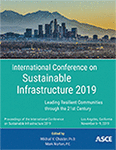International Conference on Sustainable Infrastructure 2019
Probabilistic Sustainability Assessment of Bridges Subjected to Multi-Occurrence Hazards
Publication: International Conference on Sustainable Infrastructure 2019: Leading Resilient Communities through the 21st Century
ABSTRACT
Bridges are among critical components of transportation infrastructure systems. These structures can experience multiple low probability-high consequence natural hazards, such as earthquake, during their long lifetime. Vast economic, social, and environmental consequences of seismic-induced damages to bridges demand for comprehensive multi-faceted lifecycle analysis of bridges. Commonly, the primary focus of lifecycle analysis frameworks has been the assessment of economic consequences of infrastructure investments and little attention has been given to the analysis of social and environmental impacts. This study investigates the economic and environmental impacts of various retrofit plans for bridges quantified over the lifetime of the infrastructure in order to determine the most sustainable plan. Since bridges are long-lived systems and may encounter several occurrences of earthquakes during their lifetime, effects of repair actions being incomplete prior to the occurrence of the next hazard can play a significant role in the sustainability assessment. Therefore, in this study, a probabilistic framework is developed to incorporate effects of multiple occurrences of earthquakes and incomplete repair actions for damages induced under stochastically generated future seismic events. Sustainability here is quantified in terms of economic and environmental indicators, which are based on the expected lifecycle cost, expected carbon dioxide emissions, and expected energy waste in the lifetime of the infrastructure. Results of this investigation facilitate analysis of sustainability metrics, allowing for objective consideration of sustainability in determining optimal investment decisions.
Get full access to this chapter
View all available purchase options and get full access to this chapter.
REFRENCES
Bocchini, P., & Frangopol, D. M. (2010). Optimal resilience-and cost-based postdisaster intervention prioritization for bridges along a highway segment. Journal of Bridge Engineering, 17(1), 117–129.
Collings, D. (2006). An environmental comparison of bridge forms. In Proceedings of the Institution of Civil Engineers-Bridge Engineering (Vol. 159, pp. 163–168). Thomas Telford Ltd.
Dong, Y., Frangopol, D. M., & Saydam, D. (2013). Time-variant sustainability assessment of seismically vulnerable bridges subjected to multiple hazards. Earthquake Engineering & Structural Dynamics, 42(10), 1451–1467.
El-Khoury, O., Shafieezadeh, A., & Fereshtehnejad, E. (2018). A risk-based life cycle cost strategy for optimal design and evaluation of control methods for nonlinear structures. Earthquake Engineering & Structural Dynamics, 47(11), 2297–2314.
FEMA, H. (2003). Multi-hazard loss estimation methodology, earthquake model. Washington, DC, USA: Federal Emergency Management Agency.
Fereshtehnejad, E., & Shafieezadeh, A. (2016). Multiple hazard incidents lifecycle cost assessment of structural systems considering state-dependent repair times and fragility curves. Earthquake Engineering & Structural Dynamics, 45(14), 2327–2347.
Fereshtehnejad, E., & Shafieezadeh, A. (2017). Optimal retrofit decision-making for bridge systems based on multi-hazard lifecycle cost analysis. In Eleventh International Bridge and Structures Management Conference (p. 160).
Fereshtehnejad, E., & Shafieezadeh, A. (2018). A multi-type multi-occurrence hazard lifecycle cost analysis framework for infrastructure management decision making. Engineering Structures, 167, 504–517.
Frangopol, D. M. (2011). Life-cycle performance, management, and optimisation of structural systems under uncertainty: accomplishments and challenges 1. Structure and Infrastructure Engineering, 7(6), 389–413.
Ganesh Prasad, G., & Banerjee, S. (2013). The impact of flood-induced scour on seismic fragility characteristics of bridges. Journal of Earthquake Engineering, 17(6), 803–828.
Hunkeler, D., Lichtenvort, K., & Rebitzer, G. (2008). Environmental life cycle costing. Crc press.
Itoh, Y., & Kitagawa, T. (2003). Using CO2 emission quantities in bridge lifecycle analysis. Engineering Structures, 25(5), 565–577.
Jalayer, F., Asprone, D., Prota, A., & Manfredi, G. (2011). Multi-hazard upgrade decision making for critical infrastructure based on life-cycle cost criteria. Earthquake Engineering & Structural Dynamics, 40(10), 1163–1179.
Ohio Department of Transportation (ODOT). (2010). Innovative contracting manual. Division of Construction Management.
Padgett, J. E., Dennemann, K., & Ghosh, J. (2010). Risk-based seismic life-cycle cost–benefit (LCC-B) analysis for bridge retrofit assessment. Structural Safety, 32(3), 165–173.
Padgett, J. E., & Tapia, C. (2013). Sustainability of natural hazard risk mitigation: Life cycle analysis of environmental indicators for bridge infrastructure. Journal of Infrastructure Systems, 19(4), 395–408.
Petersen, M. D., Frankel, A. D., Harmsen, S. C., Mueller, C. S., Haller, K. M., Wheeler, R. L., … Perkins, D. M. (2008). Documentation for the 2008 update of the United States national seismic hazard maps. Geological Survey (US).
TaghaviGhalesari, A., & Chang-Albitres, C. M. (2019). Sustainable Design of Rigid Pavements Using a Hybrid GP and OLS Method.
Tapia, C., Ghosh, J., & Padgett, J. E. (2011). Life cycle performance metrics for aging and seismically vulnerable bridges. In Structures Congress 2011 (pp. 1937–1948).
Welsh-Huggins, S. J., & Liel, A. B. (2017). A life-cycle framework for integrating green building and hazard-resistant design: examining the seismic impacts of buildings with green roofs. Structure and Infrastructure Engineering, 13(1), 19–33.
Welsh-Huggins, S. J., & Liel, A. B. (2018). Evaluating Multiobjective Outcomes for Hazard Resilience and Sustainability from Enhanced Building Seismic Design Decisions. Journal of Structural Engineering, 144(8), 04018108.
Yeo, G. L., & Cornell, C. A. (2009). Building life-cycle cost analysis due to mainshock and aftershock occurrences. Structural Safety, 31(5), 396–408.
Yilmaz, T., Banerjee, S., & Johnson, P. A. (2015). Performance of two real-life California bridges under regional natural hazards. Journal of Bridge Engineering, 21(3), 04015063.
Information & Authors
Information
Published In
International Conference on Sustainable Infrastructure 2019: Leading Resilient Communities through the 21st Century
Pages: 555 - 565
Editors: Mikhail V. Chester, Ph.D., Arizona State University, and Mark Norton, Santa Ana Watershed Project Authority
ISBN (Online): 978-0-7844-8265-0
Copyright
© 2019 American Society of Civil Engineers.
History
Published online: Nov 4, 2019
Authors
Metrics & Citations
Metrics
Citations
Download citation
If you have the appropriate software installed, you can download article citation data to the citation manager of your choice. Simply select your manager software from the list below and click Download.
